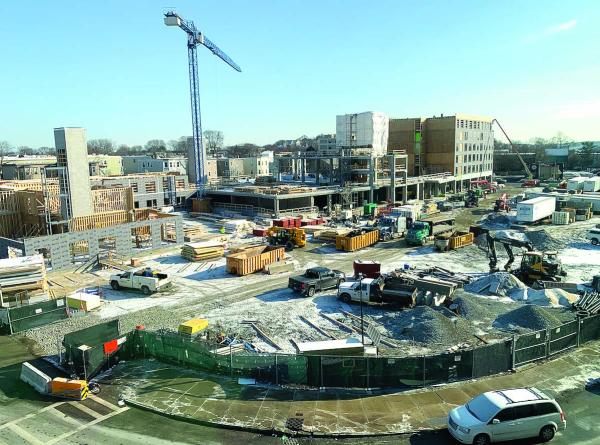January 26, 2022

The DotBlock construction site as seen from a vantage point above Hancock Street on Monday. The complex in Dorchester’s Glover’s Corner will eventually include 480 units of housing with room from retail and restaurant space and below-grade parking. Reporter photo
Frank Baker remembers that when he was first elected as a city councillor in 2011 the area around Dorchester Avenue and Hancock Street was in rough shape, featuring a meth lab, prostitutes, and johns at the prominent neighborhood intersection.
A crane towers over that area today with new buildings and a new village, including an underground garage, taking shape below it. The massive residential project, known as DotBlock, has been in the works for eight years, with shovels finally hitting the ground about a year ago.
Developers are aiming to build 480 units in two stages, with the first, holding about half of the units, expected to be completed in the spring of 2023.
“My hope is they’ll be good neighbors,” said Baker, who recently completed a tour of the construction site.
Add DotBlock to the list of big projects that are springing up across Dorchester. There is Dorchester Bay City, a commercial, residential, and laboratory-focused project on Columbia Point, which is expected to take 20 years to fully build out. The project is currently in the middle of an intensive review process under the auspices of the Boston Planning and Development Agency (BPDA).
And there’s The BEAT, the refashioned 695,000-square-foot former Boston Globe headquarters on Morrissey Boulevard that last year held leasing talks with the fitness apparel company Nobull and Flagship Pioneering, a venture capital firm that is behind some of the biggest biotechs, including Covid vaccine maker Moderna.
Next door to The BEAT, Center Court Partners, the developers behind 75 Morrissey, the former site of the Ch. 56 studios and small retail outlets, have been quiet after filing a February 2021 letter with city officials saying they’d like to build a life science and office complex spanning 250,000 square feet, as well as 175 residential units. They have pitched residential towers of 24 and 21 floors. The developers, who also own the nearby parcels containing Star Market and the Beasley Media Group building, are likely to return to city officials and civic groups with a new plan.
Down the boulevard, there are residential complexes totaling 459 units going up by Boston Bowl. In the Port Norfolk area, the “Neponset Wharf” project, just approved by city planning officials, will remake the industrial marina and add housing (120 units) with a small retail component, as well as office space.
When he joined the City Council, Baker said, a 15-unit building was considered a large project. Now Dorchester is awash in building projects that will add thousands of residential units to a region that desperately needs housing as demand outstrips supply, leading to increases in rents and home prices. The median home price in Boston is $775,000, according to Realtor.com.
But, Baker notes, there is also heavy demand for lab space. According to the trade industry group MassBIO, Massachusetts built 5 million square feet of lab space between 2020 and 2021. New projects call for an additional 20 million square feet by 2024, creating a demand for up to 40,000 new jobs, many of which come with a higher salary than in other sectors. Dorchester has multiple stops on the MBTA’s Red Line, which are considered part of a “life sciences corridor.”
“The future in Dorchester is biotech, lab space, high-tech manufacturing space,” Baker told the Reporter.
For its part, DotBlock is sticking to residential units, having increased the number to 480 from the original 362. When the first phase is done in spring 2023, half of the units will be occupancy-ready, and the landscaping and connections to the surrounding streets will be completed. There is no target date for the completion of the second stage.
The project also includes space for roughly 23,000 square feet of commercial space for what the development team itemized as “neighborhood-oriented retail and restaurant uses.” No specific tenants have yet been identified publicly.
Before the project got underway in the area popularly known as Glover’s Corner, there were a number of auto body shops, a car wash, a gas station. The area, a 10-minute walk to the Savin Hill Red Line Station, has Meeting House Hill to its South and Jones Hill to its east.
The project broke ground in the “darkest days” of the pandemic, and was split into two parts to help keep financing flowing, according to Abe Menzin, principal and executive vice president of development at Samuels & Associates, one of the companies behind DotBlock.
Menzin said that the contractors, unions, and city officials worked closely on how to proceed as the pandemic wore on. “Some of the worst fears that people had about what it would mean to build were prevented,” he said, adding that an open house is being planned for the coming weeks to publicize job opportunities.
The project did make one change in a shift to increasing electric-driven usage wherever possible, such as installing heat pumps, rather than relying totally on fossil fuels.
“The long-term goals of city and state are electrification and in this type of building, it is possible to drive more of that shift in electric versus fossil fuel heating,” Menzin said.
As for developments across Dorchester, Menzin said he and his colleagues will continue to monitor the market. He declined to comment on other projects they might have in the works.
“We’re paying close attention to everything that’s happening, and what the community’s goals continue to be,” he said.
For regular updates on Dorchester development follow @DotNews on Twitter.


